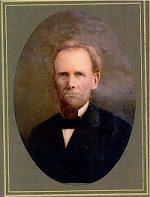Biography - Samuel W. Brown
Vince Roman, Historical Research Specialist for the law firm of Stahancyk, Kent, Johnson and Hook in Vancouver, Washington has done extensive research on the Charles Brown House at 400 W. 11th Street and the Brown family. The following article concerns early Vancouver pioneer Samuel W. Brown and his impact on the City’s developing years. For more information on the Brown House and family visit www.charlesbrownhouse.com or contact Vince Roman at 360-750-9115.
 Samuel
W. Brown was born in 1819 in Meade County, Kentucky, the tenth child of
Samuel Brown and Henrietta Hobbs. His father died when he was quite young,
leaving his mother to raise eleven children. After the death of his father
the family relocated to Knox County, Illinois. Sam was educated there and
finished his schooling at the Knox County Academy in 1842. For the next
seven years Sam endured the hardships of farm life until he was elected
sheriff of Knox County in 1849. After one term as sheriff he was elected as
the second mayor of Galesburg and in 1857 became a member of the Illinois
State Legislature. Sam most likely met President Abraham Lincoln, who would
become a personal friend, while serving in the state legislature. Sam was
also involved in the 5th Lincoln-Douglas debate held in Galesburg in 1858
and was one of the founders of Lombard College. In 1861 Lincoln appointed
Sam “Receiver of Public Moneys” in Vancouver, Washington Territory; in
essence, the person who would be in charge of money after land was sold in
the territory. Later that same year the Brown family ventured west via the
Isthmus of Panama.
Samuel
W. Brown was born in 1819 in Meade County, Kentucky, the tenth child of
Samuel Brown and Henrietta Hobbs. His father died when he was quite young,
leaving his mother to raise eleven children. After the death of his father
the family relocated to Knox County, Illinois. Sam was educated there and
finished his schooling at the Knox County Academy in 1842. For the next
seven years Sam endured the hardships of farm life until he was elected
sheriff of Knox County in 1849. After one term as sheriff he was elected as
the second mayor of Galesburg and in 1857 became a member of the Illinois
State Legislature. Sam most likely met President Abraham Lincoln, who would
become a personal friend, while serving in the state legislature. Sam was
also involved in the 5th Lincoln-Douglas debate held in Galesburg in 1858
and was one of the founders of Lombard College. In 1861 Lincoln appointed
Sam “Receiver of Public Moneys” in Vancouver, Washington Territory; in
essence, the person who would be in charge of money after land was sold in
the territory. Later that same year the Brown family ventured west via the
Isthmus of Panama.
The Brown Family settled in Vancouver, however the original location is
unknown. One possible first residency was the house at 400 W. 11th Street,
now known as the Charles Brown House, which may date back as early as 1866.
Sam himself could very well have built the original house. An article
written by Clark Brown (no relation) appeared in the Columbian in 1946
welcoming the law offices of Bates and Burnett to the neighborhood as the
first decentralized professional building in the City of Vancouver. In the
article Brown gives a brief history of the house, stating Sam Brown as its
builder. In addition to this article, a great-great granddaughter of Sam
Brown has shared how she heard throughout the years that Sam was the
builder. The house was later named after Sam’s son, and is now home to the
law offices of Stahancyk, Kent, Johnson and Hook.
There is, however, conflicting evidence as to who the original builder was.
A deed from 1874 shows the transfer of property from pioneer attorney Alonzo
Cook to Sam’s son Charles. The house is of French Second Empire
architecture, quite common and popular in the mid-late 19th century on the
East Coast where Mr. Cook was from. To this day, this style of home is
considerably rare on the West Coast. Perhaps Cook wanted to bring some East
Coast allure to Vancouver when he came west.
Regardless whether it was Alonzo Cook or Sam Brown who built the house that
has stood for almost a century and a half, Sam Brown undoubtedly had an
impact on early Vancouver development. When not acting as the Receiver of
Public Moneys, Sam ventured into several other business enterprises. He
owned the largest and most complete nursery north of California right here
in Vancouver. He was the President of the Vancouver and Yakima railroad and
Vice President of the Vancouver Transportation Company.
Having great power over much of the early Vancouver transportation system
probably gave Sam the ability to execute a neighborly ploy with impudence.
According to Brown descendant Liz Carpenter, Sam did not like the owner of a
homestead to the west of his own property. The trolley in town was slated to
run between their properties (thereby benefiting them both if they were to
plat or further develop); however, Sam re-routed the trolley through his
property, thus becoming the sole beneficiary of the trolley route. These
trolley tracks helped lay the foundation for Vancouver’s city streets.
Sam died on January 29, 1908. His wife, Harriet, preceded him in death by 19
years. One son survived him, Edward Lincoln Brown. Another son, Floyd, died
as a child, and his third son, Charles, for whom the house is named,
committed suicide in 1901 after being involved in a banking scandal.


